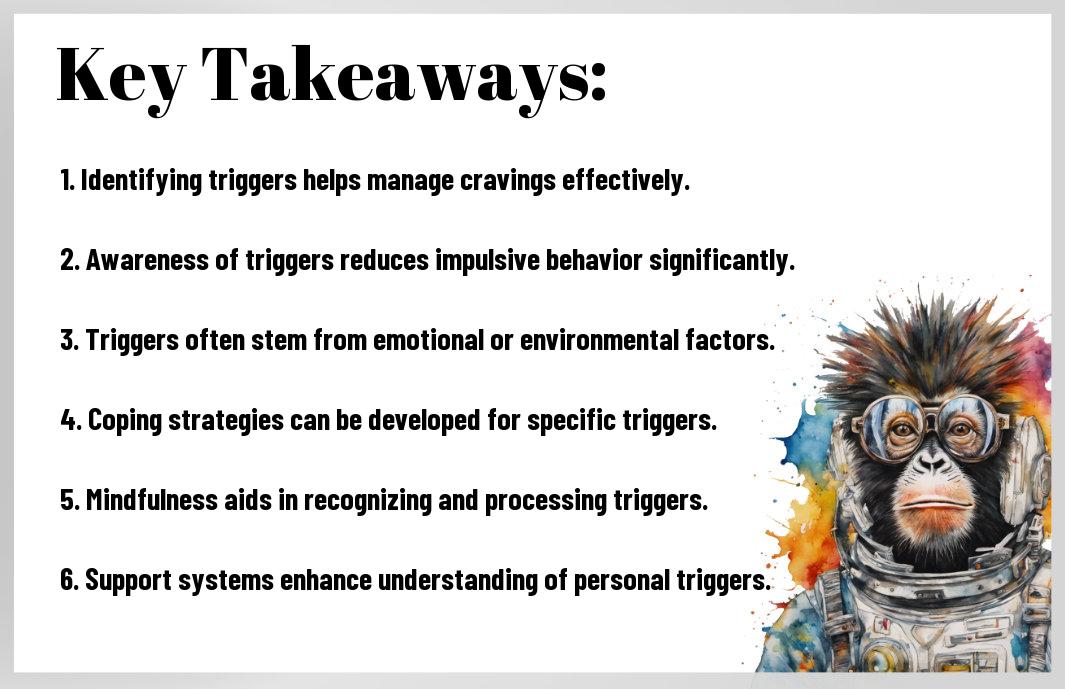It’s necessary to recognize that understanding your triggers can play a significant role in managing and even reducing cravings and compulsive behaviors. By identifying what prompts these urges in you, I believe that you can take proactive steps to address and navigate through them. This knowledge empowers you to make informed choices that can ultimately lead to a healthier relationship with food, substances, or other compulsive activities. Together, we can explore the intricate connection between triggers and the patterns they create in our lives.
Key Takeaways:
- Identifying emotional and situational triggers can provide insight into the underlying reasons for cravings, helping to develop more effective coping strategies.
- Mindfulness techniques, such as meditation and journaling, can enhance self-awareness and make it easier to recognize and manage triggers before they lead to compulsive behavior.
- Seeking support from therapy or support groups can offer guidance in understanding triggers and creating a tailored plan to address cravings and compulsions.
The Science of Triggers
What are Triggers?
Before delving deeper, it’s vital to clarify what triggers are. Triggers are specific stimuli—be they external cues like sights and sounds or internal feelings such as emotions or thoughts—that provoke a reaction in you. In many cases, these reactions are tied to past experiences and can evoke cravings or compulsive behaviors. When I say triggers, I refer to those moments when something instantly reminds you of a previous experience, leading to an immediate response, often before you even have the chance to think critically about it. They can range from something as simple as a song playing on the radio to a smell that brings back vivid memories.
How Triggers Influence Cravings
Between your personal experiences and the world around you, triggers play a significant role in shaping your cravings. They can act almost like a switch—turning on intense desires or compulsions in an instant. I’ve noticed that when I encounter a particular trigger, it doesn’t just remind me of past indulgences; it often heightens my need for whatever I’ve associated with that experience. Whether it’s a flavor, a familiar place, or an emotional state, the link between triggers and cravings is deeply ingrained. These connections create a cycle that can be hard to break, as the sight or sound can create a *feedback loop* that intensifies the craving each time its encountered.
Below the surface, it becomes evident that understanding types and sources of triggers can help you navigate your cravings more effectively. Whenever you feel a powerful urge to indulge, reflecting on the underlying trigger can provide you insight into your reactions. More importantly, I’ve found that identifying triggers not only offers clarity but also allows for the development of more effective coping strategies. For instance, recognizing a triggering situation can prompt me to engage in alternative activities or even mindfulness techniques to ground myself and redirect my focus, ultimately weakening the bond between the trigger and the craving.
Consequently, having awareness of triggers equips you with the tools to disarm their power. By exploring what specifically sets off your cravings, you are taking proactive steps to understand and reshape your responses. I’ve seen first-hand how this can lead to healthier behaviors, transforming those moments of weakness into opportunities for growth. The clearer you are about what influences you, the more empowered you become to navigate your cravings with intention and resilience.


Identifying Personal Triggers
The process of identifying personal triggers is necessary in managing cravings and compulsions. Triggers can be emotional, situational, or even sensory, and by recognizing them, I can better understand the patterns that lead to my urges. This awareness allows me to devise effective strategies to reduce the chances of succumbing to cravings. Each person’s triggers are unique, and taking the time to explore these can lead to significant insights and more control over my compulsions.
Self-Reflection Techniques
Along my journey to manage my cravings, I discovered that engaging in self-reflection techniques can be profoundly beneficial. I often set aside time for deep introspection, where I analyze my thoughts, feelings, and behaviors associated with my urges. This may include meditation, mindfulness exercises, or simply quiet contemplation where I consider what happens before I experience a craving. Through this process, I gain a clearer understanding of the emotional and situational contexts that contribute to my compulsions, allowing me to develop targeted responses.
Keeping a Trigger Journal
Personal documentation of my experiences through a trigger journal has proven to be an invaluable tool in identifying what influences my cravings. Each time I feel an urge or compulsion, I make a note in my journal detailing the specific context, emotions, and thoughts I experienced. Over time, I can observe patterns that emerge, revealing significant triggers I may not have previously recognized. This in-depth analysis helps me to anticipate situations that may lead to cravings and prepares me better to handle them.
Journal writing serves not only as a record but also as a way to externalize my thoughts and emotions. I can highlight moments that sparked strong cravings, whether they be related to stress, certain social settings, or even particular times of the day. By committing these experiences to paper, I gain a visual understanding of my journey and can spot recurring themes. The more I engage with my trigger journal, the better equipped I am to confront my cravings and implement practical strategies to manage them effectively.
Strategies to Manage Triggers
For anyone struggling with cravings and compulsions, understanding how to manage triggers is important. Effective strategies can create a significant shift in your ability to cope with these challenges. Simple changes, such as implementing mindfulness practices and developing coping mechanisms, can help you regain control over your reactions and the urge to engage in unhealthy behaviors. Whether you’re facing triggers in your daily life or during specific situations, the following strategies can empower you to achieve a healthier mindset.
Mindfulness and Awareness
Awareness is the first step toward effective management of your triggers. By incorporating mindfulness techniques into your daily routine, you can cultivate a deeper understanding of your emotional and physical responses to various stimuli. This might include meditative practices, deep breathing exercises, or simply taking a moment to pause and assess your feelings when confronted with a triggering situation. As you enhance your awareness of these responses, you’ll begin to notice patterns that lead to cravings or compulsive behaviors, allowing you to prepare better for future challenges.
Developing Coping Mechanisms
Between recognizing your triggers and acting on those feelings lies the need to develop robust coping mechanisms. It is not enough to be aware of your triggers; you must also have strategies in place for managing your cravings when they arise. This might involve finding distractions, using positive affirmations, or engaging in physical activities that can redirect your focus and energy. Each time you successfully utilize these tools, you strengthen your ability to cope with future cravings.
Triggers can often create a sense of urgency and discomfort, pushing you toward actions that do not serve your overall wellbeing. By actively identifying and managing your triggers, you make a conscious choice to engage in healthier behaviors instead. This might involve reaching out to a support system, journaling your thoughts and feelings, or practicing self-compassion. Each of these coping mechanisms is designed to empower you, enabling you to recognize that you are in control of your responses and creating a path toward a more balanced life.
The Role of Support Systems
Not everyone can tackle cravings and compulsions alone, and that’s where the power of support systems comes into play. Engaging with people who understand your struggles can make a significant difference in how you navigate these challenges. It’s important to recognize that the journey of understanding your triggers doesn’t have to be solitary. Instead, by leveraging your network, you can enhance your capacity to manage cravings and develop healthier coping mechanisms.
Involving Friends and Family
Along the way, involving your friends and family can be incredibly beneficial. Having a close-knit support group allows you to share your experiences, seek wisdom, and gain emotional reinforcement. This interaction can help create a sense of accountability, which is vital in reducing cravings. When you open up about your triggers, you enable loved ones to provide the support necessary when cravings arise. Their presence and understanding can serve as a buffer when impulses become overwhelming, reminding you of your goals and the progress you’ve made.
Professional Help and Counseling
After recognizing that your cravings might stem from deeper issues, seeking professional help can be a game-changer. Counselors and therapists can provide insights that you may not have considered, offering tailored strategies to help you understand your triggers. Professional guidance can also introduce you to established techniques aimed at managing cravings effectively. Using cognitive-behavioral therapies, for example, can help in reshaping the thought processes that contribute to compulsive behavior, which ultimately allows for more balanced decision-making.
Involving a professional doesn’t just mean attending sporadic sessions; it’s about committing to a structured approach. Your counselor can assist you in uncovering the underlying emotional or behavioral patterns related to your cravings. Engaging with a professional can introduce tools such as mindfulness and coping strategies, allowing you to make empowered choices in the moment. This partnership can be transformative, equipping you to confront your triggers head-on and significantly reducing the hold that cravings have over your daily life.

Long-Term Approaches to Reducing Cravings
Unlike quick-fix solutions that may only provide temporary relief from cravings and compulsions, adopting long-term strategies can lead to lasting change in your behavior and mindset. Understanding your triggers is just the first step; it’s vital to develop sustainable habits that can fundamentally alter your relationship with cravings. Consistently addressing the root causes of your cravings through mindfulness, self-reflection, and supportive networks can create a robust framework for resisting impulsive behaviors.
Building Resilience
One effective way to tackle cravings is by building resilience. By fostering a deeper understanding of your emotional landscape and developing healthy coping strategies, you can create a buffer against the impact of cravings when they surface. Engage in activities that promote emotional intelligence and resilience, such as journaling or seeking therapy, to better navigate your feelings instead of resorting to compulsive behaviors. This proactive approach strengthens your capacity to say no to cravings and reduces their power over your actions.
Creating a Healthy Environment
Around you, your surroundings can greatly influence your cravings and impulsive behaviors. Creating a healthy environment involves curating your spaces, both physical and social, to support your goals. For example, remove temptations from your home and replace them with healthier alternatives. Seek out social circles that encourage positive habits and invest your time in relationships that uplift your spirit. This intentional adjustment to your environment empowers you to stay aligned with your objectives and minimizes the likelihood of giving in to compulsions.
In addition, consider the role of mindful consumption in your environment—this means being conscious about what you bring into your home and how you interact with your surroundings. Surround yourself with positive influences; curate a space filled with items that inspire and motivate you rather than those that trigger cravings. Ensure that you have healthy snacks readily accessible while keeping your pantry free of unhealthy options. These small adjustments can significantly alter your response to cravings and build a stronger foundation for long-term success.
Real-Life Success Stories
To effectively combat cravings and compulsions, it’s vital to draw inspiration from those who have successfully navigated similar challenges. I’ve found that hearing real-life success stories can be incredibly motivating and enlightening. Many individuals describe transformative experiences after understanding their triggers. By leveraging insights from the 4 C’s of Addiction: Control, Compulsions, Cravings, and Consequences, they’re able to shift their perception and regain control over their choices. These narratives serve as powerful examples that can help you see the potential for change in your own life.
Case Studies of Change
An encouraging way to understand the impact of recognizing triggers is through various case studies showcasing significant improvements in individuals’ lives. Here are some inspiring examples:
- John, 34: After identifying stress as a major trigger, John adopted mindfulness techniques which led to a 50% reduction in alcohol cravings over six months.
- Amy, 29: By acknowledging social settings as a trigger, she implemented a strategy to attend fewer events, resulting in a 40% decrease in compulsive shopping behavior within three months.
- Mark, 45: Understanding that boredom spurred his cravings, Mark took up running, leading to a 60% drop in his food-related compulsions within four weeks.
- Sarah, 31: Recognizing family dynamics as triggers, she enrolled in therapy and has since maintained a 70% improvement in managing her emotions and reducing binge eating episodes.
Lessons Learned from Others
Others have laid the groundwork and provided invaluable insights into overcoming cravings and compulsions. The stories I’ve encountered emphasize the importance of self-awareness and the proactive approach of identifying triggers. Notably, many individuals shared that what they initially thought were mere cravings often had deep emotional connections or life stressors at play. Through proactive steps, such as journaling, support groups, and therapy, they found effective ways to reshuffle negative behaviors. The most dangerous oversights often stemmed from ignoring triggers, leading to relapses and frustration. Recognizing the positive outcomes others achieved offered me hope and a clearer pathway, showcasing that with determination and the right strategies, you can confidently master your impulses and take charge of your life.
Conclusion
Following this exploration of understanding your triggers, I believe that recognizing and acknowledging the specific situations or emotional states that lead to cravings and compulsions can significantly enhance your ability to manage them. When you take the time to identify these triggers, you empower yourself to develop tailored strategies to cope with or even avoid them altogether. This process allows you to make informed choices that align with your goals, contributing to a healthier lifestyle.
In my experience, the act of uncovering and understanding your triggers transforms your relationship with cravings and compulsions. With this awareness, you can cultivate a proactive mindset that fosters self-regulation and resilience. As you learn to navigate your emotional landscape, you will likely find that cravings dissipate in intensity, making it easier to maintain control over your behaviors. Ultimately, understanding your triggers not only aids in reducing cravings but also paves the way for a more fulfilling and balanced life.
FAQ
Q: What are triggers, and how do they relate to cravings and compulsions?
A: Triggers are specific stimuli – such as situations, emotions, or environments – that can provoke an urge to engage in certain behaviors, like substance use or overeating. Understanding your triggers can help you identify patterns in your cravings and compulsions, allowing you to develop strategies to manage or avoid them effectively.
Q: How can identifying my triggers reduce the intensity of my cravings?
A: By identifying your triggers, you become more aware of the situations or emotions that lead to cravings. This awareness empowers you to implement coping strategies or avoidance techniques when you encounter those triggers, potentially reducing the urgency and intensity of your cravings in those moments.
Q: Are there different types of triggers, and how can they affect my behavior differently?
A: Yes, triggers can be categorized into external (e.g., locations, social situations, or specific people) and internal (e.g., emotions or thoughts) triggers. They can affect behavior differently; for instance, external triggers might lead to immediate cravings in social situations, while internal triggers might manifest as long-term urges based on stress or anxiety. Understanding the nuances of your triggers can help you tailor your response strategies accordingly.
Q: What techniques can I use to manage my triggers and reduce cravings?
A: Various techniques can be effective, including mindfulness practices, keeping a journal to track your triggers, developing a support network, and practicing scenario planning – outlining how you will respond when faced with a specific trigger. Each individual is unique, so experimenting with different techniques may help you discover what works best for you.
Q: Can working with a professional help me understand my triggers better?
A: Yes, working with a therapist or counselor can provide valuable insight into your triggers and cravings. Professionals can guide you through the process of identifying patterns, developing coping strategies, and addressing underlying issues that may contribute to your compulsions. This tailored support can enhance your ability to effectively manage triggers and reduce cravings.





0 Comments